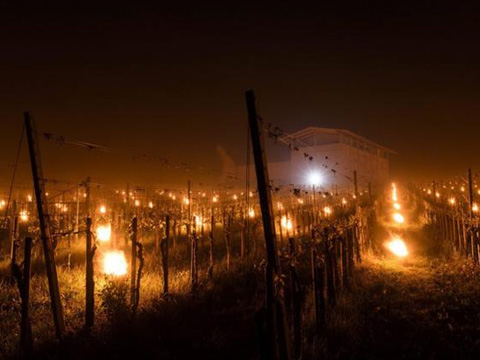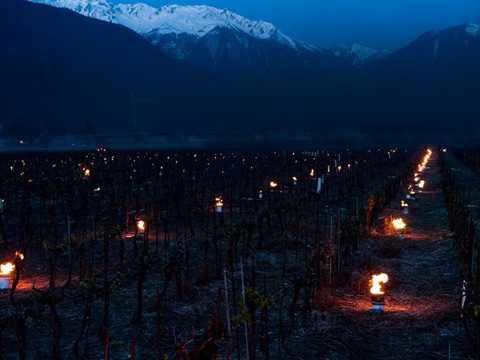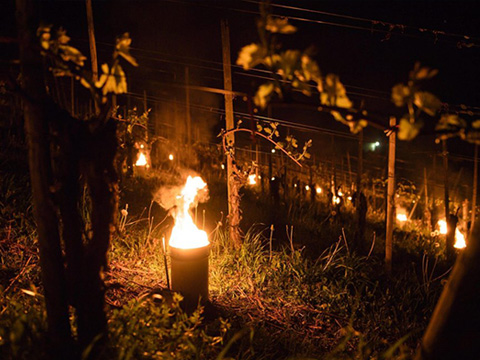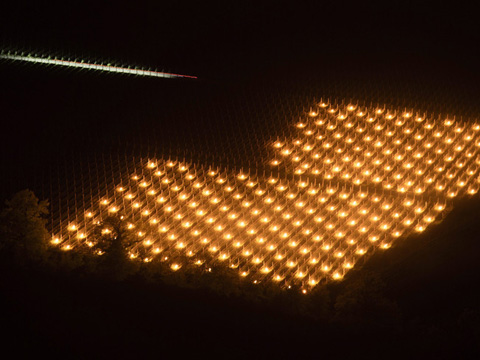Passive methods of crops freeze protection
Passive methods used well in advance of the actual freeze danger are probably the most economical and effective. Some are really only common sense and already widely used, but it is nevertheless useful to list them. Following are some examples of passive methods which can be used.
1.Site selection The land selected to grow a frost-sensitive crop should have an adequate freeze-free period. For high risk crops, avoid low-lying fields where cold air tends to drain to and be trapped. Dense windbreaks, forested areas, road embankments or other obstructions can result in "pools" of cold air by preventing the cold air from moving down the slopes. Thus the freeze risk above such obstructions may be increased. However, freeze risk of land areas below windbreaks situated along a slope may be reduced since cold air movement from higher ground is partly prevented. Protective shelterbelts properly located can create a more favourable climate which will promote earlier maturity in heat-loving crops and thus reduce the risk of freeze damage in the fall. Locations near large water bodies are usually less prone to frost as air masses over water cool less rapidly at night than over land. Coastal areas frequently experience land breezes at night which help prevent frost. Planting orchards on north-facing slopes has helped to delay blooming until the danger of frost is past in some areas.
Growers should know the risk of spring and autumn frost in their area and be aware of the variations that can be expected on their farms. Typical temperature patterns that exist in both the horizontal direction as well as vertically above crops under different types of frost situations have been described in another OMAFRA Factsheet, The Behavior of Frost in Ontario, Agdex 079. Ideally it is desirable to know when susceptible plant parts are likely to reach critical temperatures needed for damage to occur. While much information can be gained through experience, it may sometimes be helpful to make measurements of minimum temperature at various locations on the farm, particularly if the terrain is hilly or if the farm is near a lake. Temperature records can also be useful for adjusting minimum temperature forecasts for on-farm conditions. Information from nearby climate stations may often be helpful in determining frost risk, even though the station may not always represent on-farm conditions accurately. In general, it is best to seek assistance from an experienced agricultural meteorologist or climatologist if temperature data are to be collected and interpreted.
2.Land clearing Thinning hedgerows or clearing forested areas can sometimes reduce the risk of frost in sloping terrain by allowing cold air to drain to lower areas. It is preferable to seek professional advice before attempting this method since sometimes it can increase frost risk below the windbreak. In small clearings in forests, the risk of frost increases with size of clearing up to about one hectare. However, as clearings become larger than a few hectares the risk of frost is usually lowered by allowing for more air movement.
3.Crop management Select crop species and varieties which will mature within the available freeze-free period. For example, when growing grain corn, hybrids that reach maturity before killing frost should be selected. If spring frost is a threat to strawberry blossoms, growing late-flowering varieties or delay removing the straw mulch may help. Dwarf apple trees may be more likely affected by frost than taller varieties since air layers near the ground tend to be colder than at higher levels during nights with frost.
4.Plant and harvest frost sensitive crops within the available freeze-free period on your farm. Plant early enough to ensure crops are mature before killing frost in the fall. It may be advantageous to take a slightly bigger risk in spring than in fall with some crops which can be replanted if freeze damage does occur. Plant around a relatively low risk date (e.g. one which would result in freeze damage in less than 1 yr in 10, or 10% risk) rather than the average date which would result in damage in 5 yrs out of 10 (50% risk). If planting before the risk of freezing temperatures is over in spring is desirable to capture early, higher priced markets, then only plant out acreage which can be protected by one of the active freeze prevention methods. Know the risk of experiencing frost in spring and fall in the field in which the crop is being grown.
Some plants can be hardened to withstand frost by exposing the seeds or young seedling plants to varying temperature conditions, although much of this work is still in the experimental stage. Greenhouse plants are often hardened by exposure to outside conditions prior to transplanting in the field. Treatment of seeds with certain chemicals has been shown to increase hardiness in some plants. Application of proper amounts of required nutrients can also help to maintain plant hardiness.
5. Soil management The condition of the soil will affect the risk of freeze damage to both above and below ground plant parts. Loose soil surfaces reduce conduction of heat to the surface at night and therefore tend to have lower surface temperatures than compacted soils. Thus it is advisable not to cultivate the soil just before a killing frost is expected if plant parts near the ground need to be protected.
Moisture in the soil has some counteracting effects. Excessively wet soils gain less heat energy during the day as more of the sun's energy goes into evaporating moisture. This can reduce the heat available to the crop at night. On the other hand excessively dry soils are poorer heat conductors and are able to store less heat, and therefore result in a higher risk of frost. A dry peat soil is a particularly poor heat conductor and has a very low heat storage capacity, so that nighttime minimum temperatures over such surfaces may be considerably lower than over mineral soils. It may be possible to improve the heat characteristics of peat soil by the addition of mineral soil.
Mulches on the soil surface increase risk of frost by behaving as insulators. Less heat is absorbed by the soil during the day and less is released at night. Mulches can help to avoid freeze damage, however, if they completely cover the sensitive plant parts. Delaying the removal of straw mulches in strawberries in spring can sometimes help to delay the bloom date past the time when there is danger of frost. However, the straw will also delay the warming of the soil, and if it remains underneath the blossoms at the time of frost, it will increase the risk of damage.
Cover crops under orchards act similarly to mulches and thus can increase the risk of frost. They may have other beneficial effects, however, such as reducing soil erosion, which outweigh the freeze risk factor.
Covering of plant parts beneath the soil surface with a layer of soil is a way of protecting against frost. Well-hilled potatoes are less prone to experience frost damage to tubers than if the hills are poorly formed. Dry soils cool more rapidly near the surface and therefore adding moisture to the soil may sometimes help to reduce risk of frost damage to tubers.
While soil management practices may only provide a few degrees (C) of protection, even this small amount could affect freeze dates by 1 to 2 weeks or more, and in some cases could mean the difference between a total loss of the crop and relatively little damage.
The above passive methods of freeze protection are worth taking. And you can choose the last method: putting against frost candles between the trees. As an anti freeze candles wholesaler in China, we have got many clients from all over the world. And we can supply good quality against frost candles with competitive price. Welcome to send inquiry to us.
We receive enquiries in English, Español (Spanish), Русский язык (Russian), Français (French) and العربية (Arabic). Our professional team will reply to you within one business day. Please feel FREE to contact us!

.jpg)




